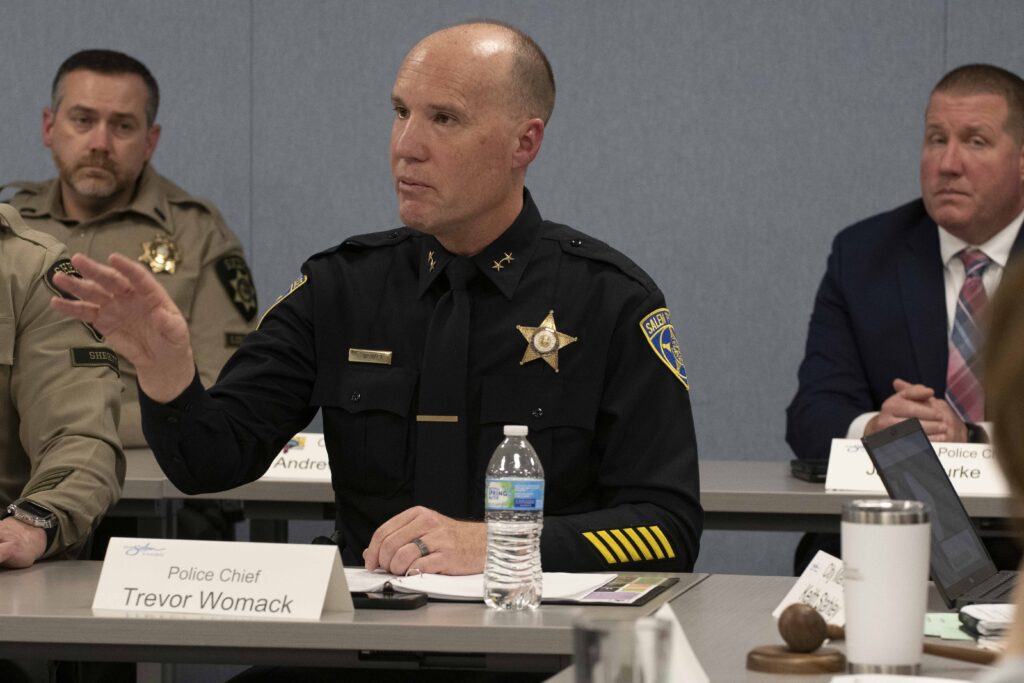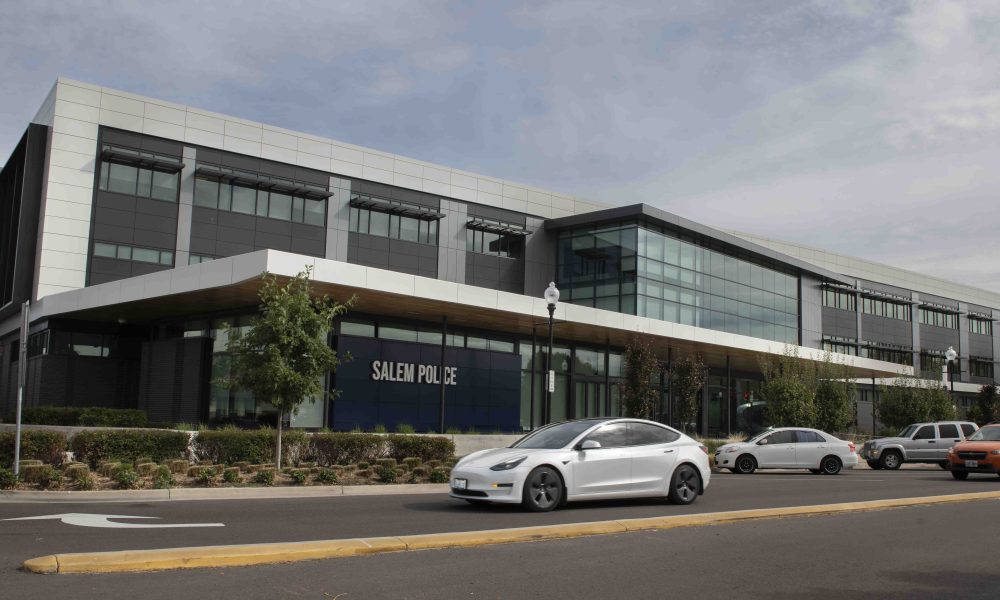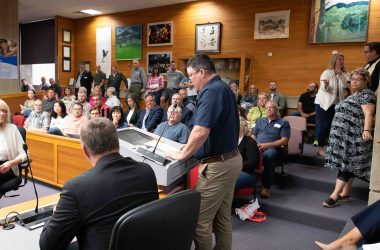Salem Police Chief Trevor Womack intends to create a new team of officers dedicated to investigating shootings in Salem that leave people wounded or dead.
Womack told Salem Reporter that the city needs around six officers assigned to such shootings to work with community organizations, pinpoint people most at risk of being assailants or victims, and steer them away from violence by getting them help.
The chief revealed his plans as police, prosecutors and city officials address a surge in gun violence in Salem. A report issued Nov. 15 found shootings in the city have doubled in the past five years and are largely concentrated in the northeast. In 2022, Salem endured 20 shootings of people, four of them fatal. Researchers didn’t count shootings outside the city limits, those involving police or reports of gunfire when no one was struck.
To create the violence intervention team, Womack said he will need to shift officers from other duties or get additional funding. Getting more money would be a challenge at a time the city already is planning budget cuts.
He said his such a community violence team would include one police sergeant and five officers and cost an estimated $900,000 a year.
Womack said he would raise the funding need in the city’s budget process, which typically starts in the spring for the following budget year.
To get the team launched sooner, Womack said he would have to cut or pull officers from other areas of his agency to prioritize shooting investigations. That could mean reducing the downtown bike team, strategic investigations unit or task force with the U.S. Drug Enforcement Administration.
“Shot callers, people that have demonstrated willingness to engage in violence in our community, those need to be our focus as far as using our law enforcement resources,” the chief said.
For others who associate with gangs but are less likely to engage in violence, he said, “we need other partners and outreach and intervention to come alongside us so we can refer those folks out to some other sort of intervention besides law enforcement.”
Salem police last year hired outside consultants to analyze gun violence.
At least half of shootings in Salem over the past five years involved gang members as victims, suspects or both, according to the report. Researchers estimate that number could be as high as 85%.
Those at most risk of being involved in violence are men between the ages of 18 and 34. Hispanic and Black men were disproportionately victims and suspects in the shootings researchers analyzed.
Womack said none of the report’s findings surprised him.
“The value of that data is it helps you focus your limited resources,” he said. “It helps have a community conversation around facts.”
The report included the researchers’ recommendations on how Salem and Marion County officials can curb such violence. One suggestion was intervening in the lives of gang members.
Womack said his department is already working with state and federal law enforcement to devise a “targeted approach” that identifies high-risk people involved in shootings and uses both police and community services to help get them out of a cycle of violence.
He said that includes continued work with the Safe Streets Task Force, a program that joins the U.S. Drug Enforcement Administration, FBI, Bureau of Alcohol, Tobacco, Firearms and Explosives, and the U.S. Attorney’s Office in Oregon.
Womack said it would be vital that his new violence prevention team coordinate with other law enforcement agencies, schools and nonprofit organizations. Once the team identifies people most likely to engage in violence, it would craft a strategy to change that for each individual.
“We’re not going to solve this problem ourselves,” he said. “We really do need some community capacity, folks where we can refer people out for effective outreach and intensive case management that’s needed. It’s not something that’s within my capacity right now or within my budget.”
He said the report and a recent joint session with the Salem City Council, Marion County Board of Commissioners and Salem-Keizer School District leaders has raised awareness of Salem’s gun violence crisis.
“More folks are beginning to reach out and say we want to help them somehow. So we’re just beginning to compile that information and put it together,” he said.

Womack said Salem may need a new community organization to get grants to boost violence intervention work. He said he isn’t aware of a local nonprofit that already employs those with “lived experiences” who can be “credible messengers” with young men at the very highest risk of committing violence or becoming victims.
“These are folks that have a criminal history, engage in very dangerous behavior. This is a specialized kind of outreach. This isn’t playing basketball with kids. This is young adult, gang outreach,” he said. “That’s why we need to have a conversation about development.”
Womack said he also wants to hold quarterly community meetings in 2024 to ask for the community’s help in curbing Salem’s gun violence problem. But he said his department lacks the resources to convene such events and gather public input on its own.
“Right now, I can’t tell you exactly what it looks like,” he said. “We’re going to need some sort of facilitator to come alongside us at the city as well as law enforcement partners in the region to facilitate those conversations and engage the community.”
At that rare joint session with commissioners and school district officials, Salem Mayor Chris Hoy announced his plan to convene community leaders to draw up ways to reduce gun violence in Salem.
Hoy said he wanted to form a new community organization to take the lead on addressing the crisis and recommendations made by the researchers. He said the group would be community-based rather than government-based but otherwise gave no details about that plan.
Meantime, due to budget constraints, Womack said his agency needs to focus more on responding – “stopping the bleeding” – than preventing more young people from moving toward violent lifestyles.
“We need to make sure that we’re identifying the highest risk people, especially people that are inclined to commit violence in our community, and building cases against those folks and reducing the risk from those incidents from happening,” he said.
“For me, it’s about approaching this with enforcement in a way that also builds trust with the community,” he said. “It’s treating people in very respectful ways, but holding them accountable at the same time. That’s a trustworthy way to approach this problem.”
The gun violence report said Salem police have lacked intelligence on local gangs since the agency disbanded its Gang Enforcement Team in 2019.
“Typically what happens, as cities implement these models and it becomes effective, the problem reduces,” he said. “At the same time, sometimes funding reduces, the priorities change, and they walk away from the model even though it’s been proven effective.”
Womack said the gang team disappeared primarily because of a lack of resources.
“We’re constantly trying to adjust here without adding staff and departments, and we’re always trying to refocus our priorities and shift our people around, he said. “I think that team fell victim to that.”
The gun violence report concluded the motives for many shootings in Salem are often personal disputes rather than gang-on-gang conflicts, even if many involve gang members.
Womack said he believes the value of the original gang team was debatable. He said the main purpose of such a team is gathering intelligence. Such expertise is needed to document factors that can result in harsher prison sentences, as is done in California. But enhanced sentences for gang involvement don’t exist in Oregon.
“What we need is a community violence intervention team. Not every single shooting involves a gang member,” Womack said. “You need to focus on the shootings and the people that are involved, regardless of what name you attach to the team.”
Womack came to Salem in December 2020 from Stockton, California, which has had its own struggles with gang violence. There, he said he learned that enforcement combined with community-based outreach and closely managing individuals is effective in intervening in the lives of gang members. He said that allows law enforcement to be “laser focused” on young men at the highest risk of offending while providing intervention outside the criminal justice system for others.
Womack said Salem leaders need a new team to assess the risk of gun violence that functions like the Marion County Child Abuse Review Team. That group includes police, prosecutors, juvenile officials and victim advocates.
“It’s about collaboration. It’s making sure that everybody who has a stake and a solution that’s necessary is at the table, communicating well,” he said.
The gun violence report excluded unincorporated east Salem. Still, researchers found that one 5-mile-square area of northeast Salem bears the brunt of the city’s shootings.
For now, Womack intends to convene his staff monthly to assess crime in northeast Salem and consider the best strategy to deal with it.
RELATED COVERAGE:
Some Salem leaders never stopped fighting gangs. They’re skeptical of the city’s new push.
Mayor plans to convene leaders to address Salem’s gun violence
Cutting Salem gun violence will take shift in police tactics, researchers say
Key findings from the city’s gun violence report
Salem shootings doubled, teen violence tripled in recent years, report finds
Contact reporter Ardeshir Tabrizian: [email protected] or 503-929-3053.
SUPPORT OUR WORK – We depend on subscribers for resources to report on Salem with care and depth, fairness and accuracy. Subscribe today to get our daily newsletters and more. Click I want to subscribe!

Ardeshir Tabrizian has covered criminal justice and housing for Salem Reporter since September 2021. As an Oregon native, his award-winning watchdog journalism has traversed the state. He has done reporting for The Oregonian, Eugene Weekly and Malheur Enterprise.









